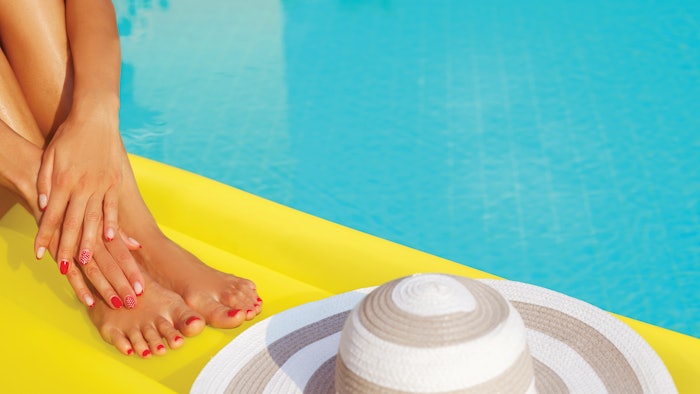
Whether the ozone layer repairs itself or not, there is a lot of cancer-causing radiation pouring down through our atmosphere. Free radicals and less humidity are present in many parts of the world. This will not be a precursor to the end of mankind, as the human race is very adaptable to ecological changes. Consider our predecessors of the 17th century: They were physically different from us, and that includes their respiratory systems. If we had the technology to bring a 17th-century person forth into our time, they would probably die of pulmonary failure.
We’ve adapted to pollution over the years, and we will adapt to more sun and less ozone over the next few generations. It’s the current generation, however, that will bear the brunt and the damage of the increasing radiation.
Summer is upon us; the sooner you educate and protect your clients, the better.
SPF Care
Not sunscreen or sun protection—I only call it sunblock! There can be no compromise with this, not anymore. There is no such thing as a healthy tan, except a fake tan. Tanning is the skin’s defense mechanism against trauma and injury. Unfortunately, when you burn your skin in the sun, even a little bit, the DNA records that insult forever and plays it back on like an organic videotape in later years. In other words, you age much faster than if you had never burned at all.
Many consumers are confused over the SPF issue, that is, which one is better or has enough protection? Again, there can be no compromise: SPF 30 is a must. Anything lower is too little and anything higher can run the risk of potential allergies to the formulation.
SPF, or sun protection factor, is measured by how long a person can be out in the sun without a sunblock before they burn. Say a typical Caucasian person can endure 30 minutes. Multiply that by 30 SPF, and we arrive at 900 minutes of possible protection with one application and no swimming or bathing. Of course, one has to be sensible. This does not mean you are fully protected if you lie out on the beach at high noon! In addition, many fair- or thinned-skinned people may have to take additional precautions such as seeking shady areas and wearing hats. The only way to have complete sun protection is to wear full-face zinc oxide cream, and then you’d look like you were wearing ivory makeup.
We do need about 20 minutes of sun a day for the vitamins and cellular activities it provides. More sun exposure than 20 minutes is risking photodamage and signs of aging, with skin cancer being at the high end of the spectrum. The standard rule I always give my patients is to lay in the sun before 10:00 a.m. or after 4:00 p.m.
Conventionally formulated sunblock is often too greasy, heavy or smelly to wear daily. Hence, most people will only wear it to the beach or by the pool, and skip it when they go to work. Wrong! The sun mercilessly glances off car windscreens, windows and any reflective object, right onto their skin as they get out of the car or move from place to place during the workweek. This wasn’t considered a big problem 20 years ago, but now it is.
There are only so many screening ingredients available, and despite what your clients may have been told about natural screens such as sesame or safflower oils, the best, most dependable ingredients are octylmethoxycinnimate, octyl salicylate and benzophenone. Parsol is also very good. Every cosmetic company has access to these acceptable ingredients but not everyone puts them into a good delivery system. The best base is a transdermal protein, a water-soluble base that disappears once applied to the skin. This type of formula encourages women in particular to wear a sunblock every day, even under makeup.
Continue reading for more safe tanning tips this summer in our DIgital Magazine...
Danné Montague-King is a botanical chemist, author and founder of DMK. For the past 50 years, DMK has used its unique DMK Skin Revision concept and treatments to provide skin care programs for all ages and ethnicities in more than 30 countries.











